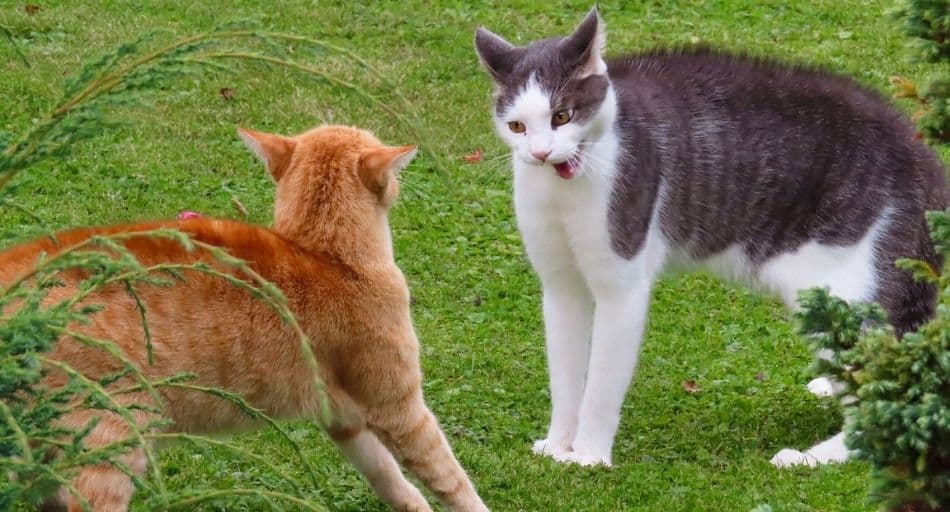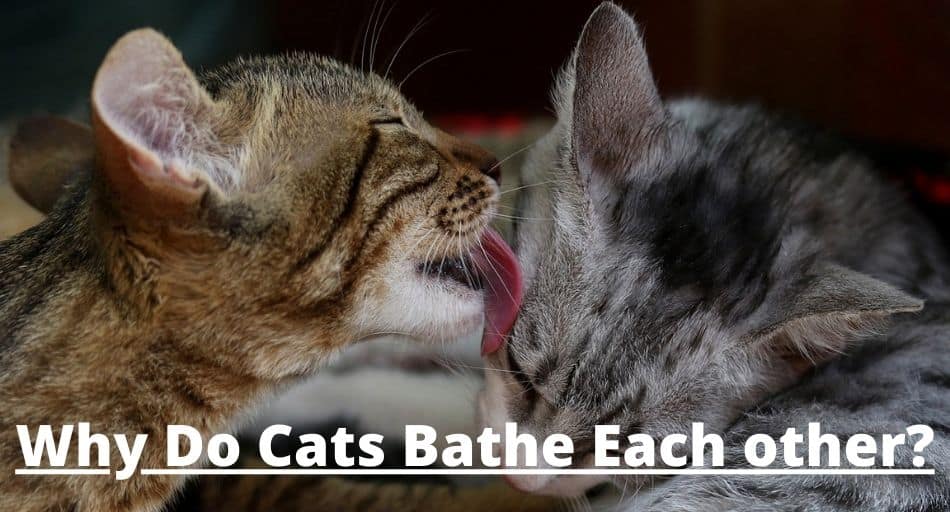As an affiliate, we earn from qualifying purchases on Amazon. We get commissions for purchases made through links in this post.
If you have more than one cat in your household, you must have seen them groom each other. Leaving you to wonder, why do cats bathe each other?
Cats are known to be excessive groomers and always like to keep themselves clean. Their excessive grooming nature has also been a course of concern such as leading to your cat gagging. But why would your cat bathe each other? Is it trying to insinuate that the other cat isn’t that clean? Or could this be something else altogether?
While others may think the main reason they do this is as a show of affection, it appears they are many more reasons for this.
Let’s get right into it.
So, Why Do Cats Bathe Each Other?
Cats bathe each other as a sign of affection especially from related cats or those that are known to get along together, leading to a better social bond and connection. This may also be a show of dominance in cats’ hierarchy. Other than that, cats generally just bathe each other to simply clean themselves. They’ll rely on other cats to reach areas such as their neck and head where they can’t clean by themselves.
Cats’ grooming will start when their motherly instincts kick in. Once she has given birth to her kittens, she’ll clean them until the kittens learn to groom themselves.
Once the kittens are all grown up, they’ll then pick up this behavior and start mutual grooming with other cats. The act of cats grooming themselves in groups is referred to as allogrooming.
A mother cat will also bathe her kittens to help keep them relaxed as well as control their body temperate. In most cases, it’s the female cat that will always groom the other cats, especially in a group of related cats. Mostly due to their motherly instincts, even though male cats do express the same behavior from time to time.
When it comes to cat hierarchy, research shows that higher-ranked cats were observed grooming lower-ranked than the other way round. An indication of dominance from higher-ranked cats. It was also noted that most higher-ranked cats would then go ahead and groom themselves as opposed to getting the same support from other cats.
Some believe that cats may also bathe each other as a way to redirect some aggressive behavior. Certain times, the cat may opt to groom each other as opposed to showing aggression or fighting with each other.
Cats may also bathe each other as a way to clean themselves after mealtime, as a means to lubricate their skin and fur as well as removing debris and dirt from injuries due to cats’ antiseptic tongues. Cats’ tongues, especially secretions from their saliva, have been known to have antibacterial and healing powers over wounds.
Is Grooming in Cats a Show of Dominance?
Cats will generally socially groom each other. While two cats may bathe each other, one cat will typically do most of the grooming compared to the other one. In most cases, the cat doing most of the grooming will be the dominant feline.
This is a show of dominance in the cats. The less aggressive (less dominant) cats will always get more grooming from the dominant cat.
There are other characteritics to indicate dominance in cats. In order to identify the dominant cat, you should be on the lookout for these other key characteristics. This will mostly be dependant on the way they confront each other.
When they are directly confronting each other, dominance in cats will be shown through, intense staring, stiffening, and rotating of the ears as well as standing upright.
When it comes to verbal confrontation, they’ll always react with a low tone as a sign of aggression. They’ll also produce such sounds with a wide-open mouth baring their teeth. These aggressive verbal confrontations would include, hissing, growling, snarling, or yowling.
Cats may also show dominance through indirect confrontation where they use preventive measures to secure some key resources. Some of the indirect confrontation behavior includes, urinating and spraying urine on vertical surfaces to mark territories.
Why Do Cats Bathe Each Other then Fight?

Social grooming in cats helps with building stronger bonds. If this is the case, then why would they start fighting all of a sudden? How is it that two cats that were comfortable with each other and bonding start fighting thereafter?
Doesn’t makes sense, right?
So, why do cats bathe each other, then fight? While it may appear as if they are fighting, they are probably not. They basically play fighting. However, when wrong buttons are pressed, the two cats may end up being aggressive, unleashing their best cat slaps, hissing, or squealing; and this could lead to real catfights that would need your intervention to make peace between the two aggregated felines.
Catfights if not stopped could end up leading to serious injuries to your feline friends. It’s therefore important to know when to stop them from fighting before they cause major harm to each other.
There is a big difference between play fighting and real cat-fights.
Play fighting involves rolling around, grabbing, and chasing each other around the house. You’ll also see them take turns when play fighting. Real fighting on the other hand has some aggression associated with it. You are also more likely to hear screams and squeals from your cat when they are having a real fight.
Why Do Cats Groom and Bite Each Other?
But why is it that when cats are grooming each other they end up biting each other’s necks? Cats will bite each other’s necks and ears as a means to remove any debris that might have been stuck on their fur. The cat will bite or nibble the focus area to ensure it’s providing a good grooming routine. Leaving the area spotless.
You’ll want to make sure they do a great job at this otherwise this could mean you doing all the cleaning later in the day.
This kind of play allows cats to be able to learn their boundaries when social grooming. They, therefore, tend to get a better understanding of the proper biting routine to ensure they don’t cause any sort of harm to each other.
Final Thought.
You now a better understanding, why cats bathe each other. This is a clear show of affection amongst cats as well as a way to show dominance. Other than that cats also bathe each other to ensure they are staying clean especially in areas that they can’t easily reach by themselves.
Cats’ motherly instincts had a major impact on cats bathing each other as they picked the entire behavior back when they were kittens.
Sometimes, simple social grooming amongst cats could also lead to serious catfights. It’s therefore important to ensure that you are able to break such fights before they turn out to be harmful to your cats.

